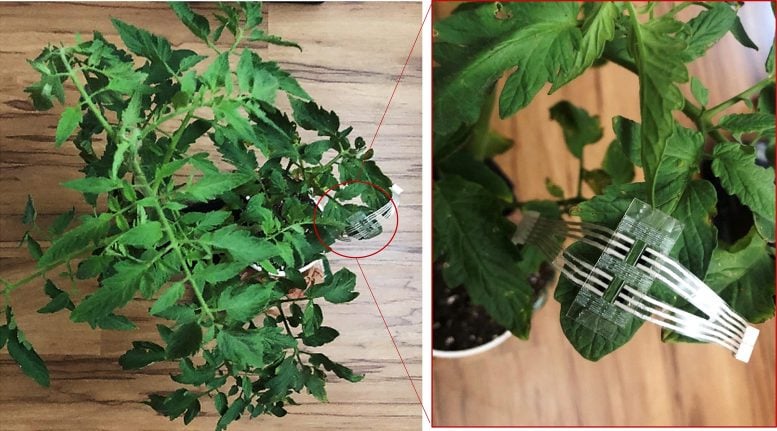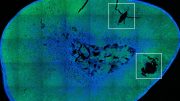
Researchers from North Carolina State University have developed a patch that plants can wear to monitor continuously for plant diseases or other stresses, such as crop damage or extreme heat. Credit: Qingshan Wei, NC State University
Researchers from North Carolina State University have developed a patch that plants can “wear” to monitor continuously for plant diseases or other stresses, such as crop damage or extreme heat.
“We’ve created a wearable sensor that monitors plant stress and disease in a noninvasive way by measuring the volatile organic compounds (VOCs) emitted by plants,” says Qingshan Wei, co-corresponding author of a paper on the work. Wei is an assistant professor of chemical and biomolecular engineering at NC State.
Current methods of testing for plant stress or disease involve taking plant tissue samples and conducting an assay in a lab. However, this only gives growers one measurement, and there is a time lag between when growers take a sample and when they get the test results.
Plants emit different combinations of VOCs under different circumstances. By targeting VOCs that are relevant to specific diseases or plant stress, the sensors can alert users to specific problems.
“Our technology monitors VOC emissions from the plant continuously, without harming the plant,” Wei says. “The prototype we’ve demonstrated stores this monitoring data, but future versions will transmit the data wirelessly. What we’ve developed allows growers to identify problems in the field – they wouldn’t have to wait to receive test results from a lab.”
The rectangular patches are 30 millimeters long and consist of a flexible material containing graphene-based sensors and flexible silver nanowires. The sensors are coated with various chemical ligands that respond to the presence of specific VOCs, allowing the system to detect and measure VOCs in gases emitted by the plant’s leaves.
The researchers tested a prototype of the device on tomato plants. The prototype was set up to monitor for two types of stress: physical damage to the plant and infection by P. infestans, the pathogen that causes late blight disease in tomatoes. The system detected VOC changes associated with the physical damage within one to three hours, depending on how close the damage was to the site of the patch.
Detecting the presence of P. infestans took longer. The technology didn’t pick up changes in VOC emissions until three to four days after researchers inoculated the tomato plants.
“This is not markedly faster than the appearance of visual symptoms of late blight disease,” Wei says. “However, the monitoring system means growers don’t have to rely on detecting minute visual symptoms. Continuous monitoring would allow growers to identify plant diseases as quickly as possible, helping them limit the spread of the disease.”
“Our prototypes can already detect 13 different plant VOCs with high accuracy, allowing users to develop a customized sensor array that focuses on the stresses and diseases that a grower thinks are most relevant,” says Yong Zhu, co-corresponding author of the paper and Andrew A. Adams Distinguished Professor of Mechanical and Aerospace Engineering at NC State.
“It’s also important to note that the materials are fairly low cost,” Zhu says. “If the manufacturing was scaled up, we think this technology would be affordable. We’re trying to develop a practical solution to a real-world problem, and we know cost is an important consideration.”
The researchers are currently working to develop a next-generation patch that can monitor for temperature, humidity and other environmental variables as well as VOCs. And while the prototypes were battery-powered and stored the data on-site, the researchers plan for future versions to be solar powered and capable of wireless data transfer.
Reference: “Real-Time Monitoring of Plant Stresses via Chemiresistive Profiling of Leaf Volatiles by a Wearable Sensor” by Zheng Li, Yuxuan Liu, Oindrila Hossain, Rajesh Paul, Shanshan Yao, Shuang Wu, Jean B. Ristaino, Yong Zhu and Qingshan Wei, 7 July 2021, Matter.
DOI: 10.1016/j.matt.2021.06.009
Co-first authors of the paper are Zheng Li, a former postdoc at NC State who is now an assistant professor at Shenzhen University, and Yuxuan Li, a Ph.D. student at NC State. The paper was co-authored by Jean Ristaino, William Neal Reynolds Distinguished Professor of Plant Pathology at NC State; Oindrila Hossain, Rajesh Paul and Shuang Wu, who are Ph.D. students at NC State; and Shanshan Yao, a former postdoc at NC State who is now an assistant professor at Stony Brook University.
The work was done with support from the NC State Chancellor’s Faculty Excellence Program; the Kenan Institute for Engineering Technology & Science; NC State’s Game-Changing Research Incentive Program for the Plant Science Initiative (GRIP4PSI); the NC State Center for Human Health and the Environment Pilot Project Award from the U.S. Department of Agriculture, number 2019-67030-29311; USDA APHIS Farm Bill grant number 3.0096; and the National Science Foundation, under grant 1728370.









Be the first to comment on "Plant Patch Enables Continuous Monitoring for Crop Stress and Diseases"